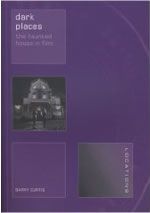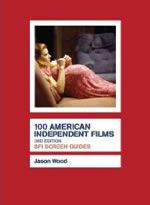 |
I have previously said in the pages of Eye For Film that I am not a horror fan - and this is broadly true. I will, however, admit to a weakness for a good ghost story, so I was more than a little eager to get my hands on a copy of Dark Places: The Haunted House In Film in order to learn more about how such stories have been presented and explored in the movies. A neat pocket-sized purple volume with a black and white photograph of 112 Ocean Avenue on the front, Dark Places is divided into four sections, each dealing with a different aspect of the haunted house as it applies to film.
The "haunted house" in film is a deceptively narrow-sounding term. In order to meet the criteria of the sub-genre it need, in fact, neither involve a house nor a ghost. Haunting as a concept is one that is simultaneously easy to grasp and much more complicated than it first appears. It's a potent idea that has been explored in film since the beginning of cinema, from the simple thrill of seeing ghosts and monsters move on screen in 19th Century "scientific" viewings to deep and layered examinations of the human condition.
Curtis covers a wide range of spaces and concepts, from the classic ectoplasmic ghost-haunting to more metaphorical revenants, and from the standard old creaky house to more unusual and modern spaces. He has clearly watched a huge number of films in the course of his writing and uses them thoroughly to back up his assertions, though I noticed a few plot points in some that had been mangled or misremembered. Nothing too dreadful, just slightly unfortunate for an otherwise rigorously argued piece.
The book is heavy on technical jargon, academic concepts and name-dropping, and so is probably best suited to a reader who is already somewhat fluent in the language and terminology of film as well as its prominent directors and theorists. Some knowledge of Gothic literature and its cultural shorthands would also be beneficial. An interested amateur (like myself, in fact) might find the text hard going in places, but Curtis has provided an extensive list of references and a select bibliography to aid in further reading, should one be inclined to take an amateur interest further.
 |
Although not quite pocket-sized, the books in the BFI Screen Guides series are reassuringly portable, with a 'friendly' feel that extends to their content. This second edition of 100 American Independent Films offers an examination of some of the key movies that have shaped the indie scene, from Edgar G Ulmar's Detour (1945) through to films such as Shotgun Stories in 2007 (although the absence of any films from last year is a little perplexing).
Definitive lists are, by their very nature, restrictive and subject to the vagaries and preferences of the editor in question - in this case Jason Wood, a freelance film consultant and co-founder of Ion Productions who certainly comes with a good indie grounding, having been involved with documentaries on the likes of Atom Egoyan and Hal Hartley. Key to enjoyment of the book is reading his entertaining and conversational introduction, which neatly outlines his perceived parameters for the films he has chosen. There is much debate these days about what constitutes an independent film, with so many studios, such as Fox Searchight and Sony Pictures Classics, now having their fingers in the pie. So much debate, in fact, that the most famous champion of independent movies - Sundance Film Festival - has recently announced a new section entitled Next, which aims to celebrate low-to-no budget filmmaking.
Wood, however, views the term 'independent' as relating more to the spirit in which a film is made and its auteristic credentials, than to a lack of studio involvement. His sentiments are echoed by Scott McGehee and David Siegel in their original preface to the 2004 edition, which still offers astute observations on the state of independents. The preface to the new edition by Swoon's Tom Kalin is, however, much less engaging (and rather poorly edited). Those who pick this book up, however, probably haven't come for the introductions, but for the primer lesson in US indie films and this is certainly a great place to start. Although it is impossible to be exhaustive with a selection of only 100 - and 'feature-length' constraints mean influential filmmakers such as Maya Deren and Kenneth Anger are not included - Wood has wisely confined himself to only one film per director (stripping out double entries from the previous edition) to give as broad a sweep as possible. Each of the film assessments offers context within the filmmaker's work, the state of independent film at the time and snappy analysis, giving a guide to the themes while leaving enough to be discovered by the viewer if they have yet to seek them out.
If you're looking for an accessible and informative guide to American indie viewing this is a good place to start.





















